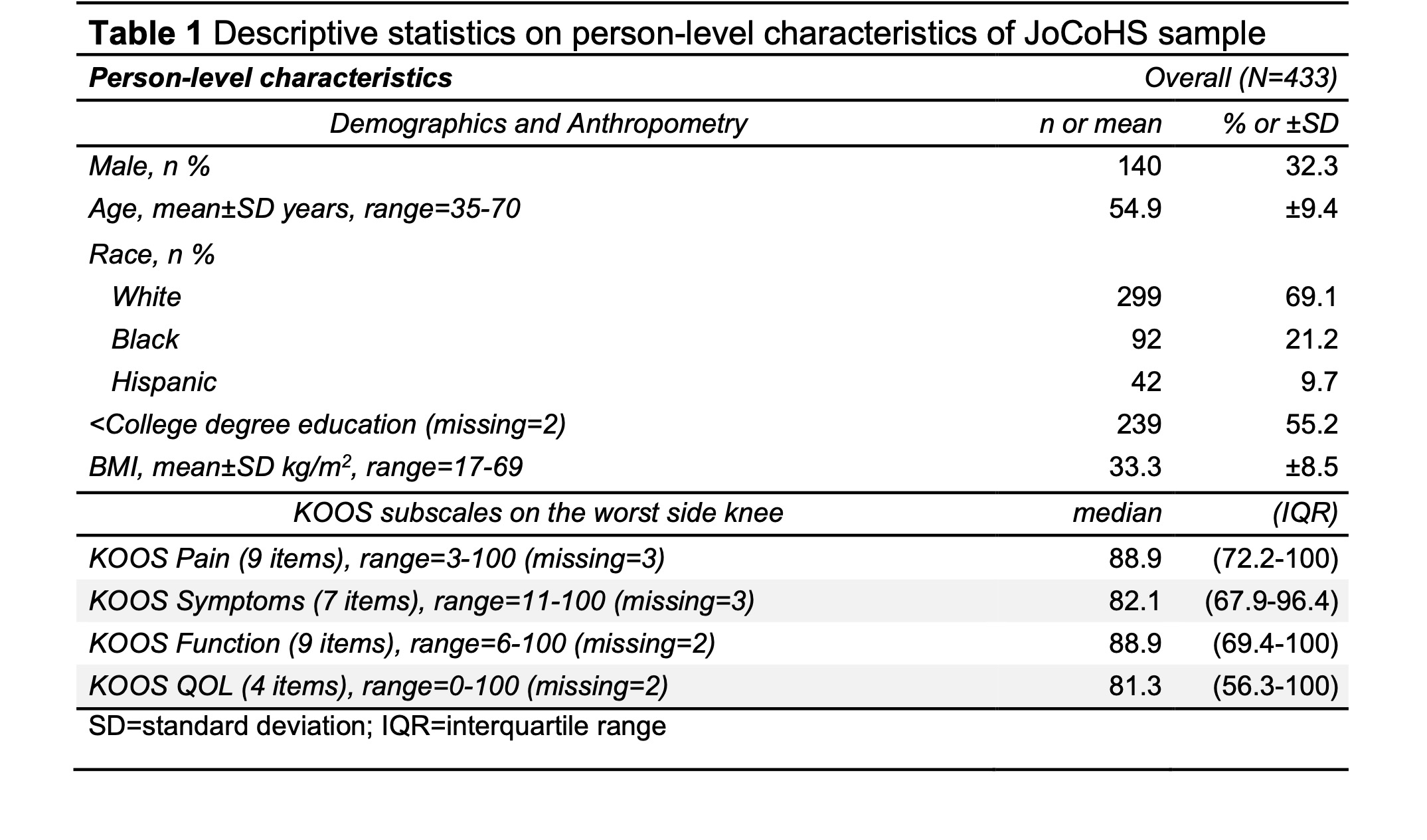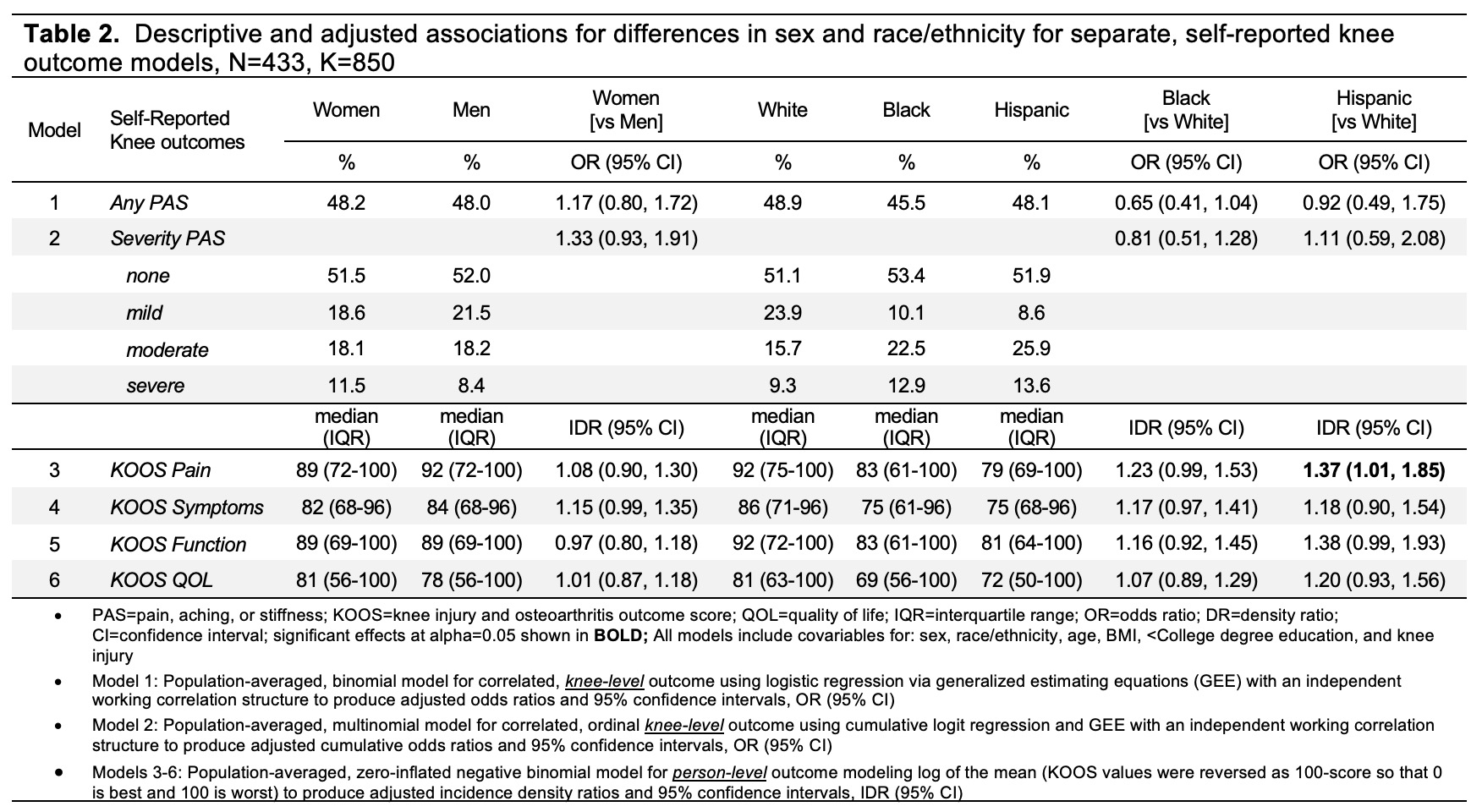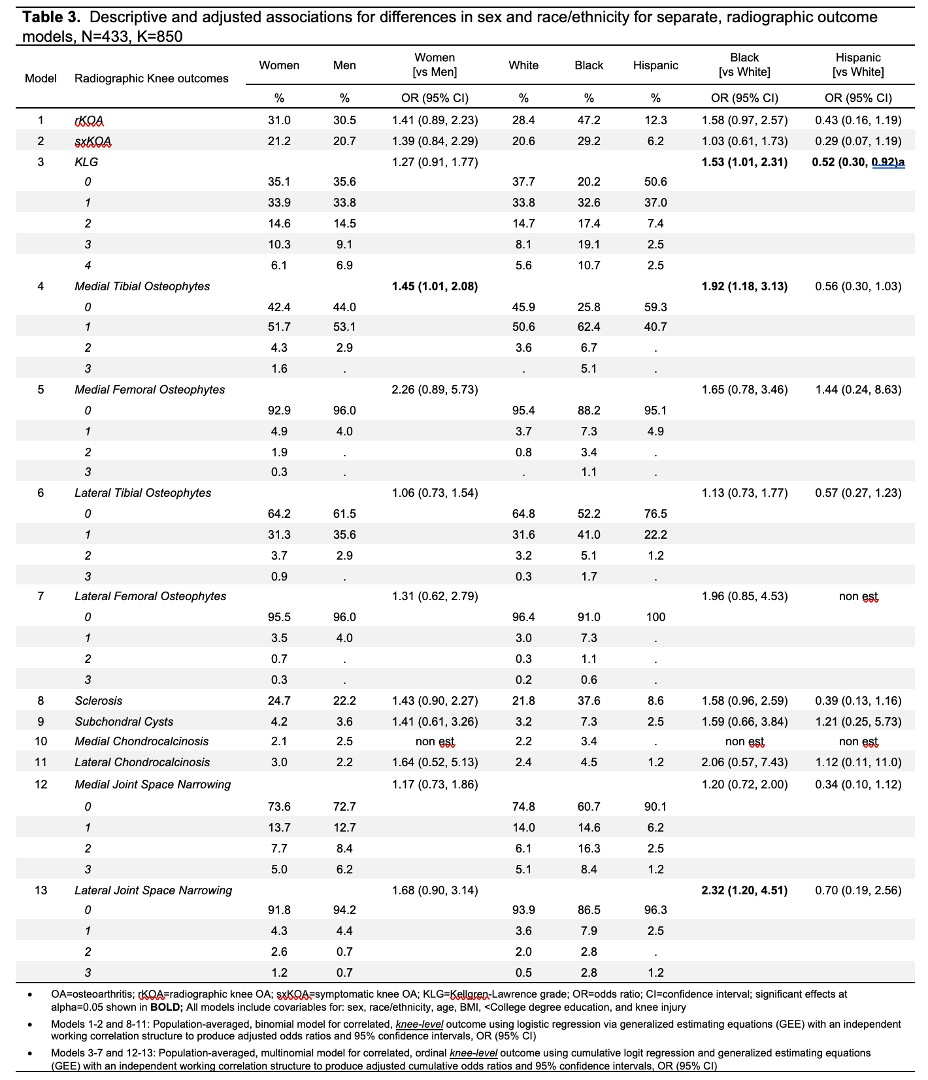Back
Poster Session A
Diversity, inclusion and racial disparities
Session: (0085–0122) Healthcare Disparities in Rheumatology Poster
0097: Sex and Race/ethnicity Differences in Knee Symptoms, Function, and Radiographic Features: Preliminary Descriptive Data from the Johnston County Health Study
Saturday, November 12, 2022
1:00 PM – 3:00 PM Eastern Time
Location: Virtual Poster Hall
- LP
Luis Palomino, MD
University of North Carolina Chapel hill
Chapel Hill, NC, United States
Abstract Poster Presenter(s)
Luis Palomino1, Carolina Alvarez2, Todd Schwartz3, Yvonne Golightly4 and Amanda Nelson2, 1University of North Carolina Chapel hill, Chapel Hill, NC, 2University of North Carolina at Chapel Hill, Chapel Hill, NC, 3University of North Carolina-Chapel Hill, Chapel Hill, NC, 4University of Nebraska Medical Center, Omaha, NE
Background/Purpose: Osteoarthritis (OA) is the most common form of joint disorder worldwide. Differences in pain, function, and radiographic features in ethnic groups, specifically Hispanics, are not well described. We aimed to describe differences in knee OA (KOA) radiographic findings, pain, and function in Non-Hispanic White (NHW), Black, and Hispanic men and women.
Methods: This is a cross-sectional study using data from the Johnston County Health Study (JoCoHS), an actively enrolling population-based study of NHW, Black, and Hispanic men and women in Johnston County, North Carolina, built on the infrastructure of the longstanding Johnston County OA Project but with a focus on younger individuals and a range of chronic health conditions. All JoCoHS participants provide demographic information, anthropometric measurements, symptomatic and functional assessments, and radiographs of major joints (excluding spine). For this analysis, we included 433 of the first 455 consecutive enrolled participants with available radiographic data. Fixed-flexion posteroanterior knee radiographs were read for Kellgren-Lawrence Grade (KLG) by an experienced radiologist. Radiographic knee OA (rKOA) was defined as KLG ³2. Pain and function were assessed via self-reported questionnaires and the Knee and Osteoarthritis Outcomes Scores (KOOS). Sex and race/ethnicity differences were assessed for radiographic and self-reported knee outcomes. At the knee level, dichotomous outcomes were modeled using logistic regression and ordinal outcomes were modeled using cumulative logit regression to produce odds ratios and 95% confidence intervals (CI), using generalized estimating equations (GEE, to accommodate correlation between knees within a person). At the person-level, continuous outcomes were modeled using zero-inflated negative binomial distribution to produce incidence density ratios (IDR) and 95% CI. All models were adjusted for age, BMI, education, and knee injury.
Results: As of 4/1/2022, 433 participants (850 knees) had completed their clinic visit and had at least one knee radiograph (Excluded were 10 people with bilateral joint replacement, 12 people missing bilateral knee x-rays, and 14 knees with unilateral joint replacement). Compared to NHW, Hispanics had a KOOS pain score that was on average 1.4 times worse (IDR 1.37 95% CI [1.01,1.85]), but had a significantly lower KLG (OR 0.52 95% CI [0.30,0.92]). Black individuals were more likely to have higher severity of medial osteophytes (OR 1.92 95% CI [1.18,3.13]), lateral joint space narrowing (OR 2.32 95% CI [1.20,4.51]) and KLG (OR 1.53 95% CI [1.01,2.13]) compared to NHW. Women were more likely to have higher severity of medial osteophytes (OR 1.45 95% CI [1.01,2.08]) compared to men. Of note, there was an observed difference that was not statistically significant towards worse KOOS (all subscales) in both Black and Hispanic individuals when compared to NHW.
Conclusion: Significant differences by race/ethnicity and sex in radiographic and symptom scores were identified in this preliminary cross-sectional analysis. This work highlights the importance of continued enrollment and study of non-White participants in OA research.



Disclosures: L. Palomino, None; C. Alvarez, None; T. Schwartz, None; Y. Golightly, None; A. Nelson, None.
Background/Purpose: Osteoarthritis (OA) is the most common form of joint disorder worldwide. Differences in pain, function, and radiographic features in ethnic groups, specifically Hispanics, are not well described. We aimed to describe differences in knee OA (KOA) radiographic findings, pain, and function in Non-Hispanic White (NHW), Black, and Hispanic men and women.
Methods: This is a cross-sectional study using data from the Johnston County Health Study (JoCoHS), an actively enrolling population-based study of NHW, Black, and Hispanic men and women in Johnston County, North Carolina, built on the infrastructure of the longstanding Johnston County OA Project but with a focus on younger individuals and a range of chronic health conditions. All JoCoHS participants provide demographic information, anthropometric measurements, symptomatic and functional assessments, and radiographs of major joints (excluding spine). For this analysis, we included 433 of the first 455 consecutive enrolled participants with available radiographic data. Fixed-flexion posteroanterior knee radiographs were read for Kellgren-Lawrence Grade (KLG) by an experienced radiologist. Radiographic knee OA (rKOA) was defined as KLG ³2. Pain and function were assessed via self-reported questionnaires and the Knee and Osteoarthritis Outcomes Scores (KOOS). Sex and race/ethnicity differences were assessed for radiographic and self-reported knee outcomes. At the knee level, dichotomous outcomes were modeled using logistic regression and ordinal outcomes were modeled using cumulative logit regression to produce odds ratios and 95% confidence intervals (CI), using generalized estimating equations (GEE, to accommodate correlation between knees within a person). At the person-level, continuous outcomes were modeled using zero-inflated negative binomial distribution to produce incidence density ratios (IDR) and 95% CI. All models were adjusted for age, BMI, education, and knee injury.
Results: As of 4/1/2022, 433 participants (850 knees) had completed their clinic visit and had at least one knee radiograph (Excluded were 10 people with bilateral joint replacement, 12 people missing bilateral knee x-rays, and 14 knees with unilateral joint replacement). Compared to NHW, Hispanics had a KOOS pain score that was on average 1.4 times worse (IDR 1.37 95% CI [1.01,1.85]), but had a significantly lower KLG (OR 0.52 95% CI [0.30,0.92]). Black individuals were more likely to have higher severity of medial osteophytes (OR 1.92 95% CI [1.18,3.13]), lateral joint space narrowing (OR 2.32 95% CI [1.20,4.51]) and KLG (OR 1.53 95% CI [1.01,2.13]) compared to NHW. Women were more likely to have higher severity of medial osteophytes (OR 1.45 95% CI [1.01,2.08]) compared to men. Of note, there was an observed difference that was not statistically significant towards worse KOOS (all subscales) in both Black and Hispanic individuals when compared to NHW.
Conclusion: Significant differences by race/ethnicity and sex in radiographic and symptom scores were identified in this preliminary cross-sectional analysis. This work highlights the importance of continued enrollment and study of non-White participants in OA research.



Disclosures: L. Palomino, None; C. Alvarez, None; T. Schwartz, None; Y. Golightly, None; A. Nelson, None.

